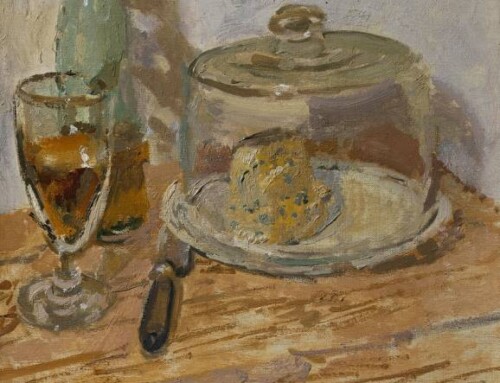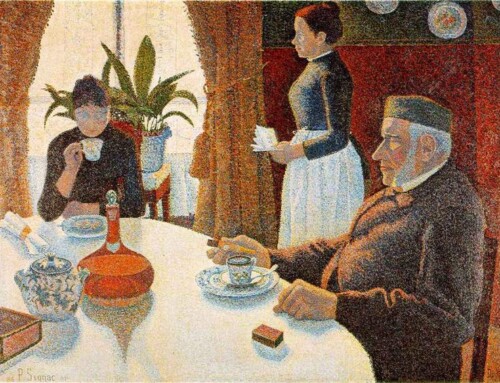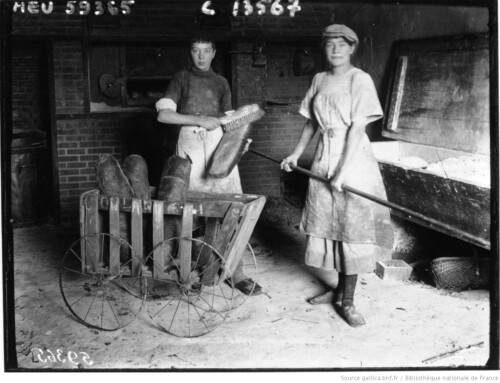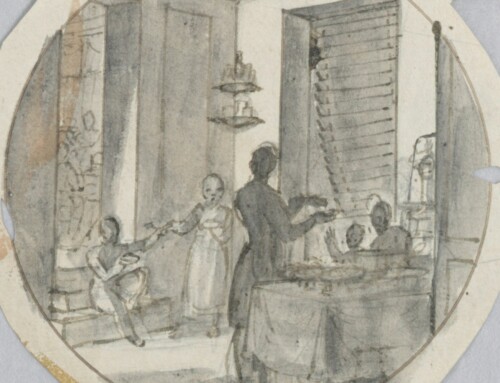Parisian eateries play an interesting part in an etching by James McNeill Whistler (1834-1903) and in a painting by Loïs Mailou Jones (1905-1998), two American artists who had spent a considerable amount of time in France.
Whistler learned to etch when he worked for two months at the U.S. Coast and Geodetic Survey (Washington, D.C.). After that job, wanting to do art, he was in Paris by 1855 with financial help from a family friend, Thomas de Kay Winans (1820-1878). There Whistler studied at the Ecole impériale spéciale de dessin and then at the Académie Gleyre. In 1857 he began to make etchings. His 1859 etching Soupe à trois sous was done while he was still in Paris: “The ‘Soupe’ was done at midnight in a low tavern, which was raided by gendarmes while he was at work. Whistler said he showed them the plate upside down, and as they could make nothing of it, they gave it back to him” (154), as noted in the February 1912 issue of The Lotus Magazine. One of the characters in the etching is mentioned briefly in The Life of James McNeill Whistler, Volume 1 (1909): “his Soupe à Trois Sous was done in a cabaret kept by Martin, whose portrait is in the print and who was famous in the Quartier for having won the Cross of the Legion of Honour by his bravery at an earlier age than any man ever decorated, and then promptly losing it by some shameful deed. And so we might go through Whistler’s etchings of this period. There is hardly one that is not a record of his daily life and of the people among whom he lived” (Pennell and Pennell 70).
Loïs Mailou Jones began teaching art at Howard University in 1930 and received a fellowship to spend a sabbatical year in France starting in the Fall of 1937. During her stay, she studied at the Académie Julian in Paris and traveled to other parts of France to paint as well. That year was such a positive experience for her that she would often return to France to paint. Haiti would become another place that she often traveled to for her art, after marrying the artist Louis Vergniaud Pierre-Noël (1910-1982) in 1953. Her 1939 painting Dans un Café à Paris (Leigh Whipper) was done while she was in the United States, however, though she would later ship it to Paris to be shown at Le Salon des artistes français. Alain Locke (1885-1954), professor of philosophy at Howard University, had spoken with her about how he felt that there was a need for more African-American artists to incorporate blackness in their artwork. Whether or not the stage and screen actor Leigh Whipper (1876-1975) was ever actually in a café in Paris is not necessarily as important as Loïs Mailou Jones having decided to place him in a setting — or to give him a role, for that matter — that American films of that era rarely offered to African-American actors. Viewers in that period of America who had a certain awareness of France would know that she placed him in an intellectual, creative place frequented by poets, artists, philosophers, novelists, and the like. That cafés in Paris were not segregated would also not be lost on such viewers. The interested reader will note that Loïs Mailou Jones was dining at restaurants on the Champs-Élysées during her first trip to Paris until her new French friend and fellow artist Céline Tabary (1908-1993) brought her to less expensive places to eat (Hill 285).
▀▄▀▄▀▄
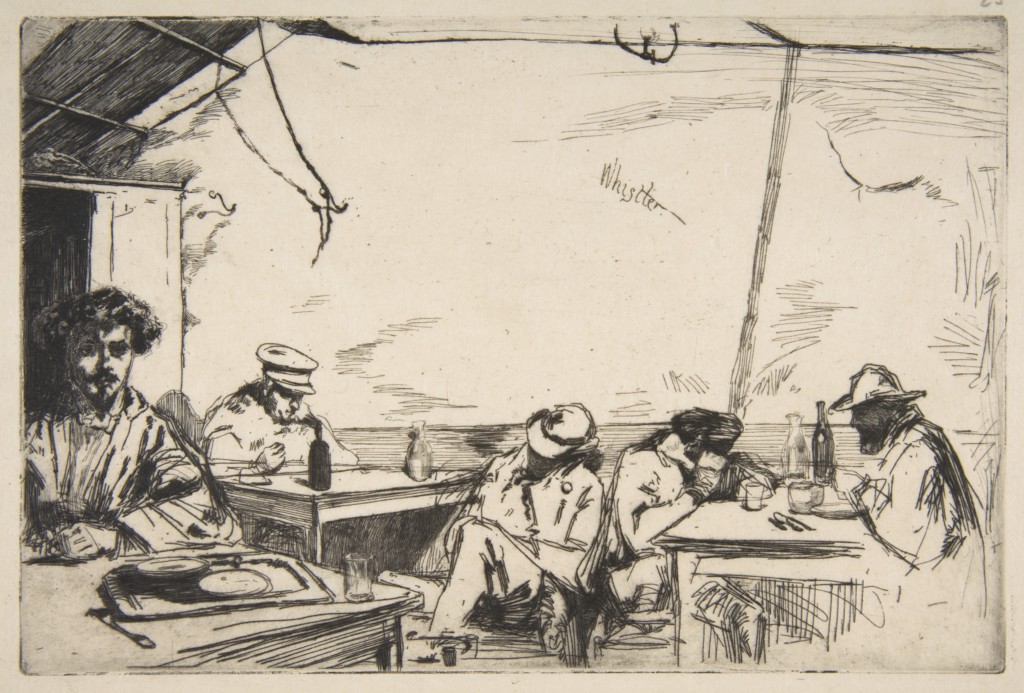
James McNeill Whistler (1834-1903). Soupe à trois sous. 1859. The Metropolitan Museum of Art → https://www.metmuseum.org/art/collection/search/365955

Loïs Mailou Jones (1905-1998). Dans un Café à Paris (Leigh Whipper), 1939. Oil on canvas, 36 x 29 in. (91.4 x 73.7 cm). Brooklyn Museum, Brooklyn Museum Fund for African American Art and gift of Auldlyn Higgins Williams and E.T. Williams, Jr., 2012.1. © artist or artist’s estate (Photo: Brooklyn Museum, 2012.1_edited_version_PS6.jpg). → https://www.brooklynmuseum.org/opencollection/objects/207854
▀▄▀▄▀▄
References & Suggested Reading
Benjamin, Tritobia Hayes. The Life and Art of Lois Mailou Jones. Pomegranate Artbooks, 1994.
Denker, Eric, et al. Fleeting Impressions: Prints by James McNeill Whistler. Montgomery Museum of Fine Arts, 2006.
Farrington, Lisa E. Creating Their Own Image: The History of African-American Women Artists. Oxford University Press, 2005.
Hill, Ruth Edmonds, ed. The Black Women Oral History Project. Cplt. Berlin/Boston: Walter de Gruyter, 2013.
“Loïs Mailou Jones.” National Museum of Women in the Arts. https://nmwa.org/explore/artist-profiles/lois-mailou-jones . Accessed November 2018.
McPhee, Constance C. “James McNeill Whistler (1834–1903) as Etcher.” The Metropolitan Museum of Art. April 2015. https://www.metmuseum.org/toah/hd/whet/hd_whet.htm . Accessed November 2018.
“Notes on Some Whistler Etchings.” The Lotus Magazine, edited by Gustav Kobbé. Feb. 1912, pp.152-56.
Pennell, Elizabeth Robins, and Joseph Pennell. The Life of James McNeill Whistler, Volume 1. W. Heinemann, 1909.
– – – . The Whistler Journal. Philadelphia: JB Lippincott, 1921.
Peters, Lisa A. James McNeill Whistler: An American Master. New York: Smithmark Publishers, 1996.
Powell, Richard J., and Jock Reynolds. To Conserve a Legacy: American Art from Historically Black Colleges and Universities. Addison Gallery of American Art, 1999.
Rowell, Charles H. “An Interview with Lois Mailou Jones.” Callaloo, vol. 12, no. 2, pp.357-378. https://xroads.virginia.edu/~ug01/westkaemper/callaloo/mailoujones.html. Accessed November 2018.
Scruggs, Dalila. “Fund for African American Art: New Acquisition.” Community: bloggers@brooklynmuseum. April 30, 2013. https://museumplanner.org/wp-content/uploads/2009/08/bloggers . Accessed November 2018.
Whistler, James Abbott McNeill, and Peter Russell. Delphi Complete Works of James McNeill Whistler (Illustrated). Delphi Classics, 2017.
